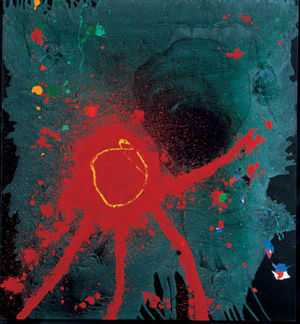John Hoyland
| John Hoyland | |
|---|---|
 Lebanon, 2007, acrylic on cotton duck, 60 x 55 inches | |
| Born |
12 October 1934[1] Sheffield, United Kingdom[1] |
| Died | 31 July 2011 (aged 76) |
| Nationality | British |
| Education |
Sheffield School of Art[1] Royal Academy Schools[1] |
| Known for | Painting |
| Awards | Appointed Professor of Painting at the Royal Academy Schools (1999)[2] |
John Hoyland RA (12 October 1934 – 31 July 2011)[3] was a London-based British artist. He was one of the country's leading abstract painters.[4]
Early life
John Hoyland was born on 12 October 1934, in Sheffield, Yorkshire, to a working-class family, and educated at Sheffield School of Art and Crafts within the junior art department (1946-51) before progressing to Sheffield School of Art and Crafts proper (1951-56),[5] and the Royal Academy Schools, London (1956-60) where Sir Charles Wheeler, the then President of the Royal Academy famously ordered that Hoyland's paintings – all abstracts – be removed from the walls of the Diploma Galleries.[2] It was only the intervention of Peter Greenham, Acting Keeper of the Schools, that saved the day when he reminded Sir Charles Wheeler that Hoyland also painted landscapes – evidence that he could 'paint properly'.[6]
In 1953 Hoyland went abroad for the first time, hitch-hiking with a friend to the South of France. After the bleakness of Sheffield it was a revelation.[7]
Career
The 1960s were a crucial decade for Hoyland; it was in these years that he found his voice as an artist.[8] Hoyland's first solo exhibition was held at the Marlborough New London Gallery in 1964 and his first solo museum show at the Whitechapel Art Gallery in 1967, curated by Bryan Robertson.[2] In the 1960s, Hoyland's work was characterised by simple shapes, high-key colour and a flat picture surface. In the 1970s his paintings became more textured.[4] He exhibited at the Waddington Galleries, London throughout the 1970s and 1980s. During the 1960s and 1970s, he showed his paintings in New York City with the Robert Elkon Gallery and the André Emmerich Gallery. His paintings are closely aligned with Post-Painterly Abstraction, Color Field painting and Lyrical Abstraction.[9] Hoyland disliked the "abstract" painter label, describing himself simply as "a painter".[10]
Retrospectives of his paintings have been held at the Serpentine Gallery (1979), the Royal Academy (1999) and Tate St Ives (2006).[2][4][11] He won the 1982 John Moores Painting Prize.[12]
His works are held in many public and private collections including the Tate.[13] In September 2010, Hoyland and five other British artists including Howard Hodgkin, John Walker, Ian Stephenson, Patrick Caulfield and R.B. Kitaj were included in an exhibition entitled The Independent Eye: Contemporary British Art From the Collection of Samuel and Gabrielle Lurie, at the Yale Center for British Art.[14][15]
He was elected to the Royal Academy in 1991 and was appointed Professor of the Royal Academy Schools in 1999.[2] The National Portrait Gallery holds portraits of the artist in its collection.[16]
Death
Hoyland died 31 July 2011 aged 76, of complications following heart surgery undertaken in 2008. He was survived by his wife Beverley Heath Hoyland and his son Jeremy, from his first marriage to Airi Karakainen. [5]
Books
- Hoyland, John (1988). Hans Hofmann, late paintings. Tate Gallery. ISBN 978-0-946590-88-9.
References
- ↑ 1.0 1.1 1.2 1.3 Lambirth, Andrew (2009). "John Hoyland: Star Thrower. Biography". Beaux Arts. Retrieved 7 April 2010.
- ↑ 2.0 2.1 2.2 2.3 2.4 "John Hoyland RA". Royal Academy of Arts. 2010. Retrieved 2 May 2010.
- ↑ Mel Gooding Obituary: John Hoyland, The Guardian, 1 August 2011
- ↑ 4.0 4.1 4.2 tate.org.uk
- ↑ 5.0 5.1 The Guardian, John Hoyland obituary, Mel Gooding 2011
- ↑
- ↑
- ↑ Lambirth 2009, p. 24.
- ↑ "Colorscope: Abstract Painting 1960-1979". Santa Barbara Museum of Art. 2010. Retrieved 2 June 2010.
- ↑ "John Hoyland". The Telegraph. 1 August 2011.
- ↑ Gooding, Mel (2006-05-06). "Sensation, revelation!". The Guardian. Retrieved 15 December 2010.
- ↑ John Moores Prize
- ↑ Tate Collection - John Hoyland
- ↑ Channeling American Abstraction, Karen Wilkin, Wall Street Journal Retrieved October 7, 2010
- ↑ NY Times, exhibition review Retrieved December 15, 2010
- ↑ npg.org.uk
Further reading
- Gooding, Mel (2006-05-01). John Hoyland. Thames & Hudson. ISBN 0-500-09330-X.
- Lambirth, Andrew (2009-10-01). John Hoyland: Scatter the Devils. Unicorn Press. ISBN 1-906509-07-7.
- Moorhouse, Paul (2006). John Hoyland: The Trajectory of a Fallen Angel. Tate Publishing. ISBN 978-1-85437-693-0.
External links
- www.johnhoyland.com
- Mel Gooding, "John Hoyland obituary", The Guardian, Monday 1 August 2011 (Retrieved 19 November 2014)
- Obituary in The Independent by Marcus Williamson
- Feature article in The Independent
- John Hoyland - Beaux Arts, exhibitions, essays, biography
- A Conversation between John Hoyland and Damien Hirst 2009
- "Six Days in September", BBC Arena Documentary 1980
|